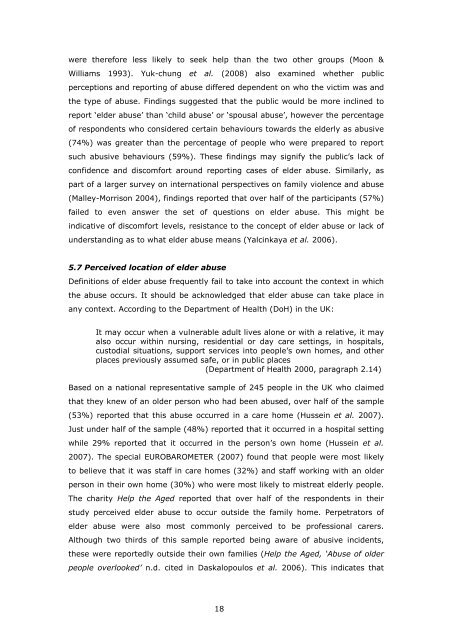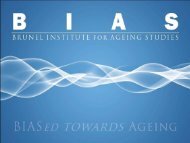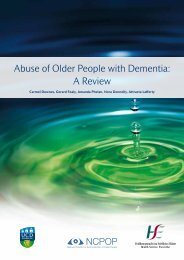Public Perceptions of Elder Abuse - Global Action on Aging
Public Perceptions of Elder Abuse - Global Action on Aging
Public Perceptions of Elder Abuse - Global Action on Aging
You also want an ePaper? Increase the reach of your titles
YUMPU automatically turns print PDFs into web optimized ePapers that Google loves.
were therefore less likely to seek help than the two other groups (Mo<strong>on</strong> &<br />
Williams 1993). Yuk-chung et al. (2008) also examined whether public<br />
percepti<strong>on</strong>s and reporting <str<strong>on</strong>g>of</str<strong>on</strong>g> abuse differed dependent <strong>on</strong> who the victim was and<br />
the type <str<strong>on</strong>g>of</str<strong>on</strong>g> abuse. Findings suggested that the public would be more inclined to<br />
report ‘elder abuse’ than ‘child abuse’ or ‘spousal abuse’, however the percentage<br />
<str<strong>on</strong>g>of</str<strong>on</strong>g> resp<strong>on</strong>dents who c<strong>on</strong>sidered certain behaviours towards the elderly as abusive<br />
(74%) was greater than the percentage <str<strong>on</strong>g>of</str<strong>on</strong>g> people who were prepared to report<br />
such abusive behaviours (59%). These findings may signify the public’s lack <str<strong>on</strong>g>of</str<strong>on</strong>g><br />
c<strong>on</strong>fidence and discomfort around reporting cases <str<strong>on</strong>g>of</str<strong>on</strong>g> elder abuse. Similarly, as<br />
part <str<strong>on</strong>g>of</str<strong>on</strong>g> a larger survey <strong>on</strong> internati<strong>on</strong>al perspectives <strong>on</strong> family violence and abuse<br />
(Malley-Morris<strong>on</strong> 2004), findings reported that over half <str<strong>on</strong>g>of</str<strong>on</strong>g> the participants (57%)<br />
failed to even answer the set <str<strong>on</strong>g>of</str<strong>on</strong>g> questi<strong>on</strong>s <strong>on</strong> elder abuse. This might be<br />
indicative <str<strong>on</strong>g>of</str<strong>on</strong>g> discomfort levels, resistance to the c<strong>on</strong>cept <str<strong>on</strong>g>of</str<strong>on</strong>g> elder abuse or lack <str<strong>on</strong>g>of</str<strong>on</strong>g><br />
understanding as to what elder abuse means (Yalcinkaya et al. 2006).<br />
5.7 Perceived locati<strong>on</strong> <str<strong>on</strong>g>of</str<strong>on</strong>g> elder abuse<br />
Definiti<strong>on</strong>s <str<strong>on</strong>g>of</str<strong>on</strong>g> elder abuse frequently fail to take into account the c<strong>on</strong>text in which<br />
the abuse occurs. It should be acknowledged that elder abuse can take place in<br />
any c<strong>on</strong>text. According to the Department <str<strong>on</strong>g>of</str<strong>on</strong>g> Health (DoH) in the UK:<br />
It may occur when a vulnerable adult lives al<strong>on</strong>e or with a relative, it may<br />
also occur within nursing, residential or day care settings, in hospitals,<br />
custodial situati<strong>on</strong>s, support services into people’s own homes, and other<br />
places previously assumed safe, or in public places<br />
(Department <str<strong>on</strong>g>of</str<strong>on</strong>g> Health 2000, paragraph 2.14)<br />
Based <strong>on</strong> a nati<strong>on</strong>al representative sample <str<strong>on</strong>g>of</str<strong>on</strong>g> 245 people in the UK who claimed<br />
that they knew <str<strong>on</strong>g>of</str<strong>on</strong>g> an older pers<strong>on</strong> who had been abused, over half <str<strong>on</strong>g>of</str<strong>on</strong>g> the sample<br />
(53%) reported that this abuse occurred in a care home (Hussein et al. 2007).<br />
Just under half <str<strong>on</strong>g>of</str<strong>on</strong>g> the sample (48%) reported that it occurred in a hospital setting<br />
while 29% reported that it occurred in the pers<strong>on</strong>’s own home (Hussein et al.<br />
2007). The special EUROBAROMETER (2007) found that people were most likely<br />
to believe that it was staff in care homes (32%) and staff working with an older<br />
pers<strong>on</strong> in their own home (30%) who were most likely to mistreat elderly people.<br />
The charity Help the Aged reported that over half <str<strong>on</strong>g>of</str<strong>on</strong>g> the resp<strong>on</strong>dents in their<br />
study perceived elder abuse to occur outside the family home. Perpetrators <str<strong>on</strong>g>of</str<strong>on</strong>g><br />
elder abuse were also most comm<strong>on</strong>ly perceived to be pr<str<strong>on</strong>g>of</str<strong>on</strong>g>essi<strong>on</strong>al carers.<br />
Although two thirds <str<strong>on</strong>g>of</str<strong>on</strong>g> this sample reported being aware <str<strong>on</strong>g>of</str<strong>on</strong>g> abusive incidents,<br />
these were reportedly outside their own families (Help the Aged, ‘<str<strong>on</strong>g>Abuse</str<strong>on</strong>g> <str<strong>on</strong>g>of</str<strong>on</strong>g> older<br />
people overlooked’ n.d. cited in Daskalopoulos et al. 2006). This indicates that<br />
18









